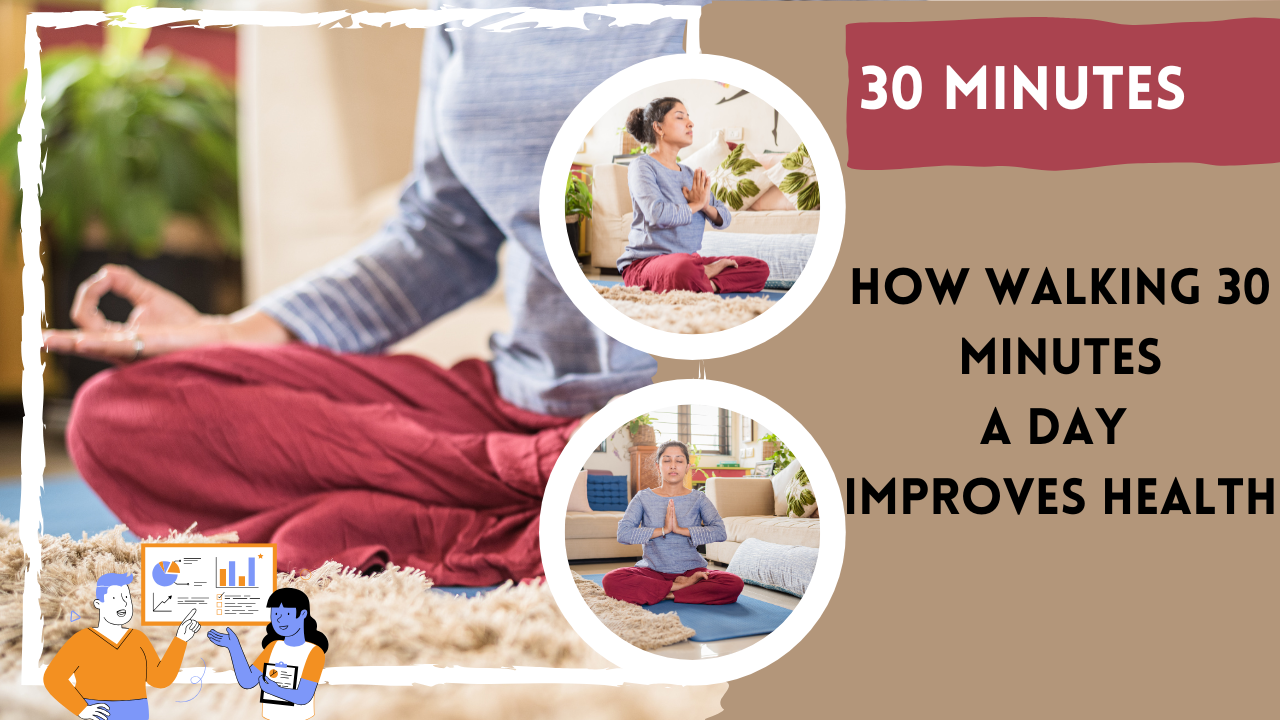Introduction
Have you ever wondered how a simple activity like walking could significantly improve your overall health? What if dedicating just 30 minutes a day to walking could transform your body, mind, and longevity? Studies show that walking is one of the easiest and most effective forms of exercise, yet many people overlook its benefits. Unlike high-intensity workouts, walking is low-impact, accessible to all fitness levels, and requires no special equipment.
From boosting heart health and aiding weight loss to improving mental well-being, walking can be the foundation of a healthier lifestyle. In this article, we’ll explore the science-backed benefits of walking for 30 minutes daily and provide actionable tips to incorporate it into your routine.
The Science Behind Walking for Health

Walking might seem too simple to be a powerful exercise, but research suggests otherwise. According to the Harvard Medical School, walking can reduce the risk of heart disease by 35% and lower the chances of developing Type 2 diabetes by 40%. The Mayo Clinic also highlights how walking supports better joint health, reduces stress levels, and improves circulation.
Dr. James Levine, a leading researcher at the Mayo Clinic, states:
“Walking is the best medicine for longevity. It is the most accessible and sustainable form of exercise with life-changing benefits.”
Walking at a brisk pace (about 3–4 mph) activates various muscle groups, enhances cardiovascular function, and increases calorie expenditure. More importantly, it improves oxygen flow to the brain, leading to better cognitive function and emotional well-being.
Physical Health Benefits of Walking Daily

1. Improves Heart Health
Walking is a natural way to strengthen the heart and reduce the risk of cardiovascular diseases. Regular walking helps:
- Lower blood pressure by improving circulation.
- Reduce LDL cholesterol (bad cholesterol) and increase HDL cholesterol (good cholesterol).
- Prevent heart attacks and strokes.
A study published by the American Heart Association found that walking for 150 minutes per week (equivalent to 30 minutes per day, five days a week) can cut the risk of heart disease by nearly 30%.
2. Supports Weight Loss and Boosts Metabolism
Walking burns calories, which helps in weight management. The number of calories burned depends on weight and pace:
| Weight (lbs) | Calories Burned (30 min at 3 mph) | Calories Burned (30 min at 4 mph) |
|---|---|---|
| 125 lbs | 120 kcal | 150 kcal |
| 155 lbs | 140 kcal | 175 kcal |
| 185 lbs | 160 kcal | 200 kcal |
Even without dieting, consistent walking can help reduce body fat and prevent obesity. A combination of brisk walking and incline walking enhances calorie burn and activates different muscle groups.
3. Strengthens Muscles and Joints
If you suffer from joint pain or stiffness, walking can help improve joint mobility and reduce arthritis symptoms. Walking increases synovial fluid production, which lubricates the joints and keeps them flexible.
Additionally, walking strengthens key muscle groups, including:
- Legs (quadriceps, hamstrings, calves).
- Core muscles, leading to better posture and balance.
- Lower back muscles, reducing the risk of back pain.
4. Boosts Immunity
Did you know walking can help you fight off common illnesses? Research published in the British Journal of Sports Medicine found that individuals who walked at least 30 minutes daily had 43% fewer sick days than those who didn’t exercise. Walking:
- Increases immune cell production.
- Helps fight infections.
- Reduces inflammation in the body.
Mental Health Benefits of Walking
1. Reduces Stress and Anxiety
Walking outdoors, especially in green spaces, can significantly lower cortisol levels (stress hormone). This practice, known as forest bathing, has been widely studied in Japan for its therapeutic effects on mental health.
2. Enhances Cognitive Function and Memory
- Walking improves brain circulation, increasing oxygen and nutrient flow.
- Studies by the Alzheimer’s Association show that regular walking reduces the risk of dementia by 40%.
- It improves problem-solving skills and focus, making it a great activity before work or study sessions.
3. Boosts Mood and Happiness
Ever heard of the “walker’s high”? Walking releases endorphins, the body’s natural mood boosters. It helps fight depression and enhances feelings of well-being.
- Case Study: John, a 45-year-old teacher, struggled with anxiety and low energy levels. After committing to a daily 30-minute walk, he noticed a dramatic improvement in his mood, focus, and overall happiness.
Walking for Longevity: The Fountain of Youth?
Many Blue Zone studies (regions where people live the longest) show that walking plays a crucial role in lifespan extension. Walking prevents chronic diseases such as:
- Type 2 Diabetes (reduces insulin resistance).
- Osteoporosis (improves bone density).
- Hypertension (lowers blood pressure naturally).
Dr. Walter Willett from Harvard T.H. Chan School of Public Health states:
“People who walk at least 30 minutes daily add years to their life expectancy.”
How to Start a Daily Walking Routine
1. Set Realistic Goals
- Start with 10 minutes a day, then gradually increase to 30 minutes.
- Use a step tracker (like Fitbit or Apple Health) to monitor progress.
2. Walking Techniques for Maximum Benefits
- Maintain good posture (straight back, relaxed shoulders).
- Walk at a moderate to brisk pace (aim for 3.5–4 mph).
- Use arm swings to increase intensity.
3. Making Walking More Enjoyable
- Listen to music, podcasts, or audiobooks.
- Walk with a friend, pet, or group.
- Explore new trails or parks for variety.
Common Myths & Misconceptions About Walking
❌ Myth: Walking isn’t effective for weight loss.
✔️ Truth: Brisk walking burns calories and fat, aiding long-term weight management.
❌ Myth: You need intense workouts for real health benefits.
✔️ Truth: Walking provides long-term cardiovascular and metabolic benefits.
7-Day Walking Plan for Beginners
| Day | Walking Goal | Additional Tips |
|---|---|---|
| Monday | 20 min, moderate pace | Choose a scenic route |
| Tuesday | 30 min, brisk pace | Listen to an audiobook |
| Wednesday | 20 min, hilly terrain | Engage core muscles |
| Thursday | 30 min, mixed pace | Walk with a friend |
| Friday | 40 min, slow pace | Relax and enjoy nature |
| Saturday | 30 min, interval walking | Alternate fast & slow pace |
| Sunday | 45 min, leisure walk | Reflect & practice gratitude |
Recommended Royalty-Free Images & Infographics
- Image: People walking in nature (Pexels, Unsplash).
- Infographic: “10 Benefits of Walking Daily.”
- Calories burned table infographic.
Conclusion & Call to Action
Walking 30 minutes a day is one of the simplest yet most effective ways to improve physical and mental well-being. It enhances heart health, brain function, weight management, and even longevity.
So, what’s stopping you? Lace up your shoes and take your first step toward a healthier, happier life today!
Have you experienced the benefits of daily walking? Share your thoughts in the comments! 🚶♂️💪
Readmore…https://totalinsights.online/wp-admin/post.php?post=28783&action=edit

